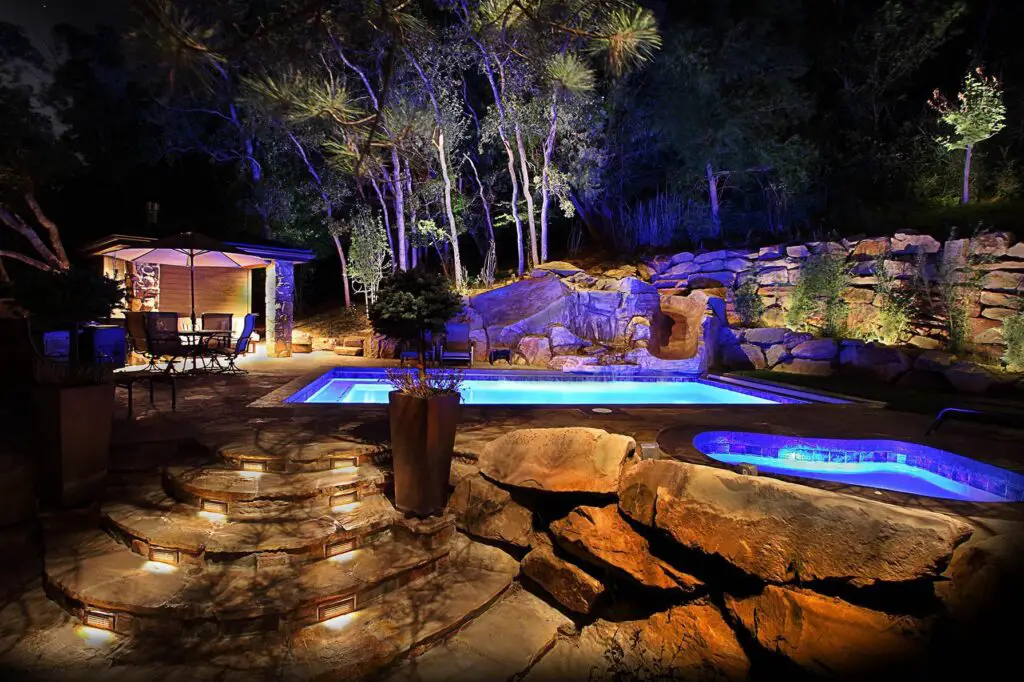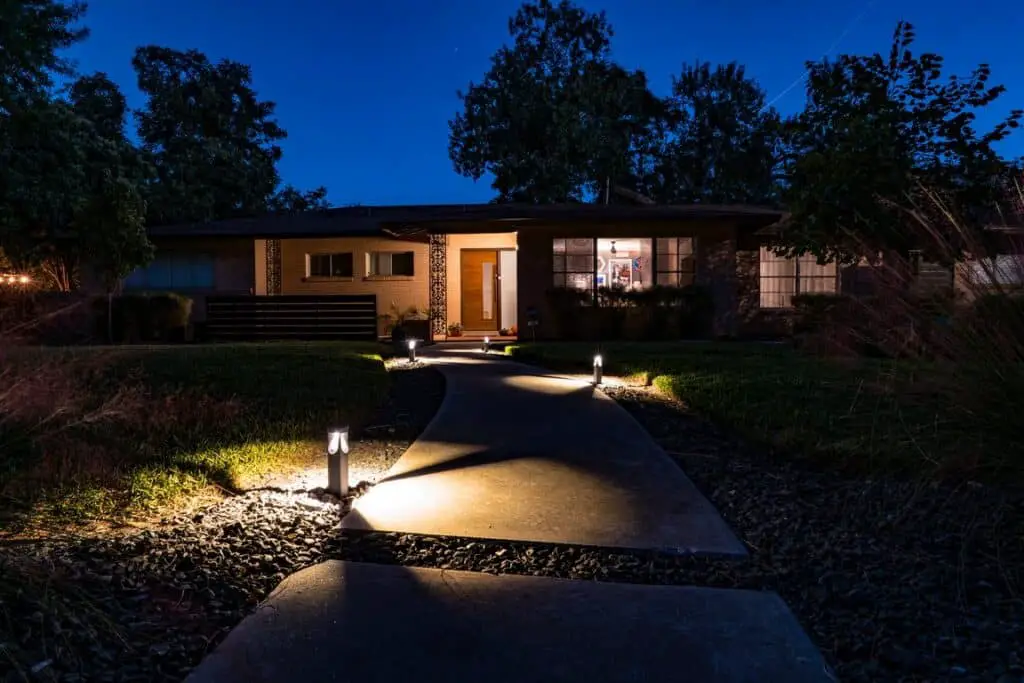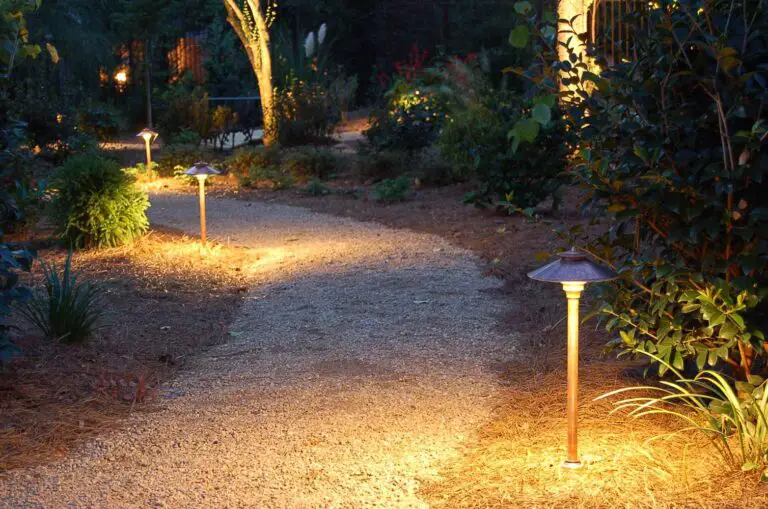Introduction
How Far Can You Run Low Voltage Landscape Lighting: Low voltage landscape lighting is a popular choice for homeowners looking to enhance the beauty and functionality of their outdoor spaces. Whether you want to illuminate a pathway, highlight architectural features, or create a warm and inviting ambiance, low voltage lighting offers a versatile and energy-efficient solution.
Low voltage landscape lighting systems typically operate at 12 volts, which is significantly lower than the standard household voltage of 120 volts. This lower voltage not only reduces the risk of electrical shock but also allows for longer cable runs without significant voltage drop. However, the maximum distance that you can run low voltage landscape lighting depends on various factors, including the wattage of the lights, the gauge of the wire, and the overall layout of your lighting system.
When it comes to determining the maximum distance for running low voltage landscape lighting, the wattage of the lights plays a crucial role. Because of the increased power consumption, higher wattage lights have a limited effective range. While higher wattage lights experience voltage drop over longer distances, lesser wattage lights are more resilient to this effect. It is essential to check the manufacturer’s specifications for each light fixture to determine its wattage and the recommended maximum cable run.
Voltage Landscape Lighting
The gauge of the wire used in your low voltage landscape lighting system also affects the maximum distance. Thicker wires have a lower resistance, which helps to minimize voltage drop over longer cable runs. The most common wire gauges used for low voltage landscape lighting are 12, 14, and 16. While 12-gauge wire is the thickest and offers the least resistance, it is also more expensive. 14-gauge wire is a popular choice for most residential applications, providing a good balance between cost and performance. 16-gauge wire is suitable for shorter cable runs or low wattage lighting systems.
Your low-voltage landscape lighting system’s maximum distance depends on its wattage, wire gauge, and design. Series-connected lights lose more voltage than parallel-connected lights. Discuss your lighting system with a qualified landscape lighting designer or electrician to ensure proper planning and installation.
Understanding the elements that affect low voltage landscape lighting’s maximum distance is essential for optimal performance and voltage drop prevention. You may construct a gorgeous outdoor lighting design that brightens your landscape for years by considering the wattage of the lights, the wire gauge, and the arrangement of your lighting system.

How far can you run low voltage landscape lighting wire?
When it comes to low voltage landscape lighting, one common question that arises is how far can you run the wire. This is an important consideration as it determines the feasibility and effectiveness of your lighting setup. The distance over which you can run low voltage landscape lighting wire depends on various factors, including the voltage of the system, the gauge of the wire, and the wattage of the lights.
Voltage and Wire Gauge:
The system voltage is a major factor in deciding the maximum wire length. Low voltage landscape lighting systems typically operate at 12 volts or 24 volts. With a lower voltage, a longer length of wire can be used without the voltage dropping significantly. For example, a 12-volt system can typically support wire runs of up to 100 feet, while a 24-volt system can extend up to 200 feet.
Wattage and Wire Size:
Another factor to consider is the wattage of the lights and the gauge of the wire. Higher wattage lights require thicker wire to minimize voltage drop. A smaller number indicates a thicker wire gauge, and vice versa. For instance, a 12-gauge wire is thicker than a 16-gauge wire. For longer cable runs or greater wattage lighting, a bigger wire gauge is suggested for maximum performance.
Considerations for Longer Wire Runs:
For wire runs exceeding the recommended distances, there are a few strategies you can employ to mitigate voltage drop. One option is to use a multi-tap transformer, which allows you to divide the wire runs into multiple shorter segments. This helps distribute the voltage more evenly and reduces the impact of voltage drop. Additionally, using a higher voltage system, such as a 24-volt setup, can also extend the maximum wire run distance.
What is the voltage range for LED landscape lighting?
LED landscape lighting is a popular choice for outdoor lighting due to its energy efficiency, long lifespan, and versatility. One important aspect to consider when installing LED landscape lighting is the voltage range. The voltage range for LED landscape lighting typically varies depending on the specific product and its intended use. In this article, we will explore the voltage range for LED landscape lighting and discuss its significance in ensuring optimal performance and safety.
LED landscape lighting
Systems generally operate on low voltage, typically ranging from 12 volts to 24 volts. There are a number of advantages to working at lower voltages. Firstly, it enhances safety by reducing the risk of electrical shock. When operating in damp or rainy conditions, low voltage systems are preferred since they provide less of a risk to homeowners and workers. Also, low voltage lighting has fewer negative effects on the environment and the wallet than its high voltage counterparts.
LED landscape lighting projects demand careful consideration of voltage range options. The voltage needs depend on the lighting circuit length, number of fixtures, and power source distance. Determine the optimal voltage range for a lighting installation by consulting the manufacturer’s specifications or seeking expert advice.
LED landscape lighting
Systems need transformers to convert 120 volts home voltage to low voltage for fixtures. The transformer is essential to maintaining fixture voltage. To ensure fixture operation and lifetime, choose a transformer that meets the LED landscape lighting system’s voltage needs.
Do low voltage landscape lights use a lot of electricity?
Low voltage landscape lights are a popular choice for outdoor lighting due to their energy efficiency and versatility. These lights operate on a lower voltage than traditional lighting systems, typically ranging from 12 to 24 volts. This lower voltage not only reduces the risk of electrical shock but also results in lower energy consumption. Thus, low voltage landscape lighting is well-known for having a negligible effect on monthly electricity costs.
Low-voltage landscape lights give adequate illumination while using much less electricity than typical lighting. To accomplish this, we make use of energy-saving light sources like LEDs, which consume less power without sacrificing light quality. LED lights are suitable for outdoor illumination due to their long lifespan and low energy usage.
Advanced technology like timers and motion sensors make low voltage landscape lighting even more energy efficient. Users can regulate light hours to ensure they are only on when needed. The lights activate when motion sensors detect movement, saving energy during inactivity.
Besides energy efficiency, low voltage landscape lights offer several design alternatives. These lights come in a variety of forms, sizes, and colors, allowing homeowners to build decorative outdoor lighting schemes. Low voltage landscape lights may illuminate walkways, architectural structures, and landscaping to produce amazing visual effects.
Can low voltage landscape lighting cause a fire?
Low voltage landscape lighting is a popular choice for homeowners looking to enhance the beauty and safety of their outdoor spaces. However, questions concerning the safety of this kind of illumination due to the possibility of fire have been raised. In this article, we will explore whether low voltage landscape lighting can indeed cause a fire.
Firstly, it is important to understand that low voltage landscape lighting operates at a significantly lower voltage than traditional lighting systems. These systems often run on 12 volts or less, which is safe for use in the great outdoors. The low voltage reduces the risk of electrical shock and minimizes the potential for fire hazards.
Furthermore, safety precautions are built into low voltage landscape lighting systems to prevent overheating and fires. These systems often include transformers that convert the standard household voltage to the lower voltage required for the lighting. The thermal overload protection in the transformers cuts power to the system if the temperature rises above a predetermined threshold.
In addition to the safety features built into the lighting systems, proper installation and maintenance are crucial to minimizing the risk of fire. It is essential to follow the manufacturer’s instructions and guidelines when installing low voltage landscape lighting. This involves taking precautions to prevent the wiring from being damaged by things like digging or the weather.
Regular maintenance is also important to prevent any potential fire hazards. This includes inspecting the wiring and connections for any signs of wear or damage, as well as keeping the lighting fixtures clean and free from debris. If problems are found, it’s best to get in touch with an electrician right away.
Can you run low voltage landscape wire through wall?
Yes, it is possible to run low voltage landscape wire through a wall. Low voltage landscape lighting systems are a popular choice for illuminating outdoor spaces such as gardens, pathways, and patios. The standard voltages of 12 and 24 for such systems make them suitable for home use. Running the wire through a wall can help to conceal it and create a neater and more professional-looking installation.
When running low voltage landscape wire through a wall, it is important to follow certain guidelines to ensure safety and compliance with electrical codes. Using wire that is made for outdoor and underground applications is the first and most important step. This type of wire is resistant to both moisture and UV rays, making it suitable for direct burial. Using the correct wire will help to prevent damage and ensure the longevity of the system.
Before running the wire through the wall, it is important to determine the most suitable route. This may involve drilling holes through the wall or using conduit to protect the wire. It is essential to avoid any existing electrical wiring or plumbing pipes to prevent damage and potential hazards. It is also wise to check the applicable construction codes and ordinances to avoid breaking any rules or breaking the law.
Extra Layer Of Protection Against Damage
Use conduit when passing the cable through the wall to protect it and simplify maintenance. In the event that the wire needs to be upgraded or replaced, the addition of conduit is helpful for both purposes. Choose the right conduit size and type for the job and fasten it to the wall to avoid movement or damage.
The maximum distance low voltage landscape lighting can run without voltage drop depends on several factors. Wire gauge is important for installation. Thicker wire gauges, such 12 or 10, have lower resistance and can transport electricity great distances without voltage drop. Thinner wire gauges like 16 or 18 gauge may shed voltage significantly over longer distances.
Another factor to consider is the total wattage of the lighting system. Higher wattage systems will require thicker wire gauges and shorter distances to minimize voltage drop. Additionally, the type of transformer used to power the low voltage lighting can also impact the maximum distance. High-quality transformers with better voltage regulation capabilities can allow for longer runs without significant voltage drop.
If you want to reduce the voltage loss to a minimum, keep your low voltage landscape lighting within a radius of 100 to 200 feet. Beyond this distance, the voltage drop can become more noticeable, leading to dimmer lights and potential performance issues. It is crucial to consult with a professional or refer to the manufacturer’s guidelines to determine the specific maximum distance for your low voltage landscape lighting setup.
How does the length of the wire used for low voltage landscape lighting affect its performance and efficiency?
Low voltage landscape lighting performance and efficiency depend on wire length. Voltage drop increases with cable length. Due to wire resistance, lighting fixtures receive less voltage. Thus, light performance and brightness can suffer.
Longer wire lengths result in higher resistance, which in turn leads to greater voltage drop. This voltage drop can cause the lights to appear dimmer and less vibrant, compromising the overall aesthetic appeal of the landscape lighting. Additionally, the reduced voltage reaching the fixtures can impact their functionality and lifespan. The lights may flicker or fail to operate at their full potential, resulting in a less effective lighting system.
When building a low voltage landscape lighting system, wire gauge and fixture distance from the power source are crucial. A thicker, lower-gauge wire reduces resistance and voltage drop. A voltage booster or several power sources strategically positioned along the line can also reduce voltage drop over long distances. Long-distance low-voltage landscape lighting is possible with proper planning and execution, including consideration of the wire length.
Are there any specific factors or variables that can impact the distance low voltage landscape lighting can be run?
The maximum safe distance for installing low-voltage landscape lighting depends on a number of factors and variables. One of the key factors is the gauge or thickness of the wire used for the lighting system. Thicker wires have lower resistance and can carry electrical current over longer distances without significant voltage drop. In order to increase the range of low voltage landscape lighting, a thicker wire is required, such as a lower gauge number.
Another factor that can impact the distance is the total wattage or power consumption of the lighting fixtures. When power exceeds wire or transformer capacity, voltage loss can occur over long distances. To avoid voltage drop, determine the lighting system’s total wattage and make sure it fits the wire and transformer’s capacity.
The maximum allowed distance for low voltage landscape lighting can also be affected by the quality and condition of the wire connections and splices. Poorly made or corroded connections can increase resistance and result in voltage drop. It is crucial to use high-quality connectors and regularly inspect and maintain the wire connections to ensure optimal performance and minimize voltage drop.
What are the potential consequences or issues that may arise if low voltage landscape lighting is run beyond its recommended distance?
Running low voltage landscape lighting beyond its recommended distance can lead to several potential consequences and issues. One of the main problems is voltage drop, which occurs when the electrical current encounters resistance in the wire over long distances. As the voltage drops, the lights may become dimmer and less effective, ultimately compromising the overall lighting design and functionality of the landscape.
Another issue that may arise is overheating of the wire and the lighting fixtures. When a wire is stretched beyond its limits, the current it carries increases, and the wire overheats. This can not only damage the wire itself but also pose a fire hazard. Similarly, the lighting fixtures may also overheat, leading to reduced lifespan and potential malfunction.
Furthermore, running low voltage landscape lighting beyond its recommended distance can result in increased maintenance and replacement costs. Dimmer lights may require additional fixtures to compensate for the lack of illumination, leading to higher expenses. Additionally, the strain on the wire and fixtures may cause them to wear out more quickly, necessitating frequent replacements and repairs.
Are there any recommended techniques or equipment that can be used to extend the distance low voltage landscape lighting can be run while maintaining optimal performance?
Using a variety of techniques and tools, low-voltage landscape lighting may be installed at greater distances without sacrificing efficiency. One essential strategy is using bigger gauge lighting wiring. Thicker wires, such 12 or 10 gauge, reduce resistance and voltage drop along the cable. This lets you travel farther without voltage loss.
In addition to using a larger gauge wire, another technique is to utilize voltage regulators or boosters. These devices help to regulate and stabilize the voltage, ensuring that the lighting fixtures receive a consistent and adequate power supply even over longer distances. Any voltage drop throughout the wire route can be mitigated by strategically placing voltage regulators.
Furthermore, it is important to consider the placement and arrangement of the lighting fixtures themselves. By spacing the fixtures closer together, the overall distance that the wire needs to cover can be reduced. This can help to minimize voltage drop and maintain optimal performance. Additionally, using LED bulbs instead of traditional incandescent bulbs can also contribute to extending the distance that low voltage landscape lighting can be run. LED bulbs are more energy-efficient and require less power, allowing for longer wire runs without sacrificing brightness or performance.

Conclusion
The thickness of the wire utilized in the lighting system is also crucial. Thicker wires have lower resistance, which means they can carry electricity over longer distances without significant voltage drop. Therefore, using a thicker gauge wire can allow for longer cable runs. However, it is essential to consult the manufacturer’s guidelines or an electrician to determine the appropriate wire gauge for your specific lighting setup.
Additionally, the type of lighting timers fixtures and the wattage of the bulbs used can affect the maximum cable run. Higher wattage bulbs draw more current, which can result in more significant voltage drop over longer distances. So, think about how much juice each light fixture needs, and pick bulbs that can handle the distance the cables will have to travel.
Lastly, the terrain and layout of your landscape can also impact the maximum cable run for low voltage lighting. If there are obstacles such as trees, buildings, or uneven terrain, it may be necessary to install additional transformers or use multiple cable runs to ensure adequate lighting coverage. Planning the layout carefully and considering potential obstacles can help optimize the performance and reach of your low voltage landscape lighting system.
In conclusion, the maximum cable run for low voltage landscape lighting depends on voltage, wire gauge, bulb wattage, and landscape plan. Manufacturer instructions or professional assistance can help your lighting system work efficiently and beautifully illuminate your outside environment.

